Financial Reporting, Costing Methods and Accounting Report - UK Retail
VerifiedAdded on 2020/02/05
|7
|1447
|321
Report
AI Summary
This report provides an introduction to accounting, focusing on the conceptual framework for financial reporting, the users of accounting information, and the characteristics and limitations of costing methods. The report explores the purpose of the conceptual framework in preparing and maintaining financial records, generating ideas for quality services, and managing resources. It also examines the various users of accounting information, including management, shareholders, and creditors, and how accounting information supports their decision-making. Furthermore, the report delves into marginal and absorption costing methods, highlighting their applications in financial and managerial accounting, and discusses their respective advantages and drawbacks in short-term and long-term planning and decision-making. The report concludes by emphasizing the importance of accounting concepts and the conceptual framework for effective business operations.
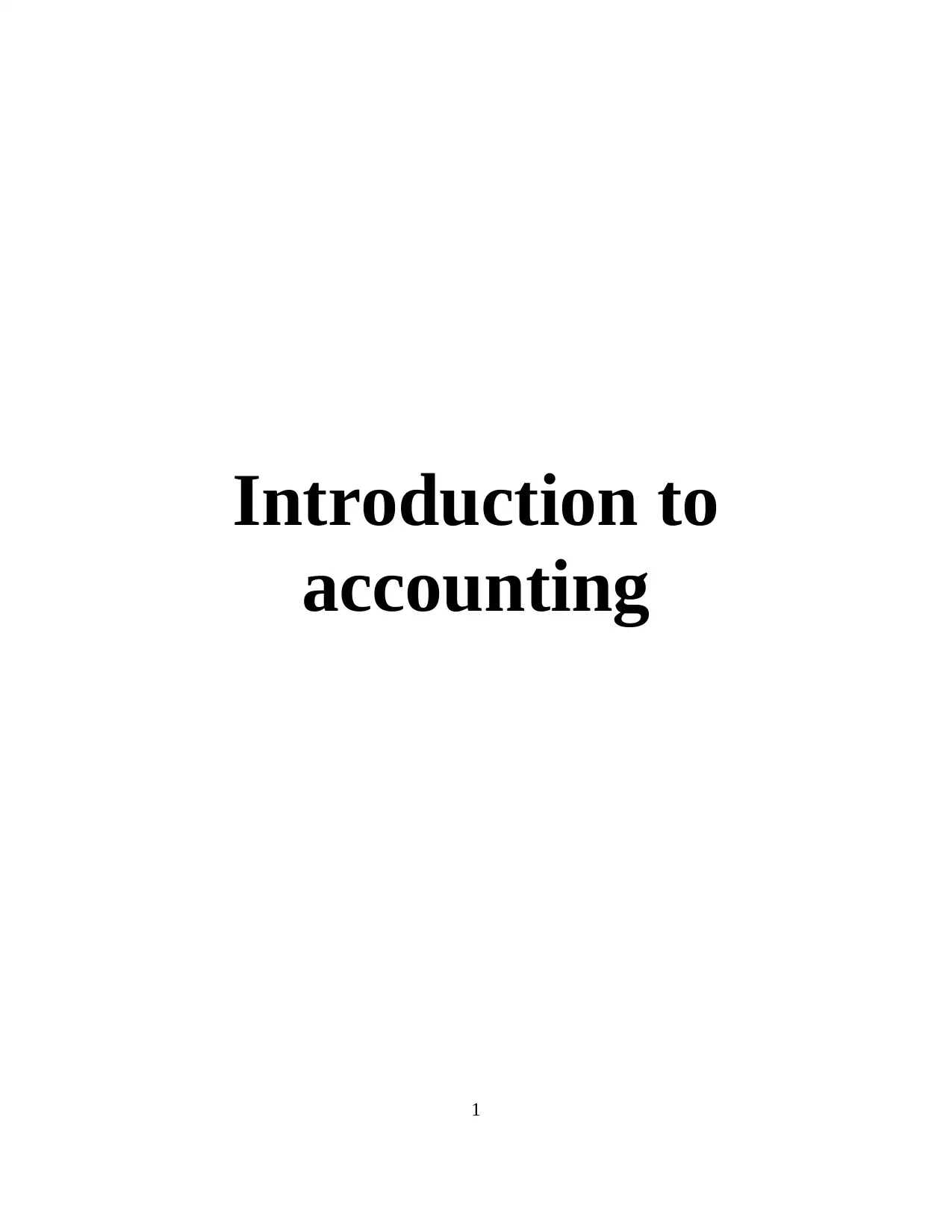
Introduction to
accounting
1
accounting
1
Paraphrase This Document
Need a fresh take? Get an instant paraphrase of this document with our AI Paraphraser
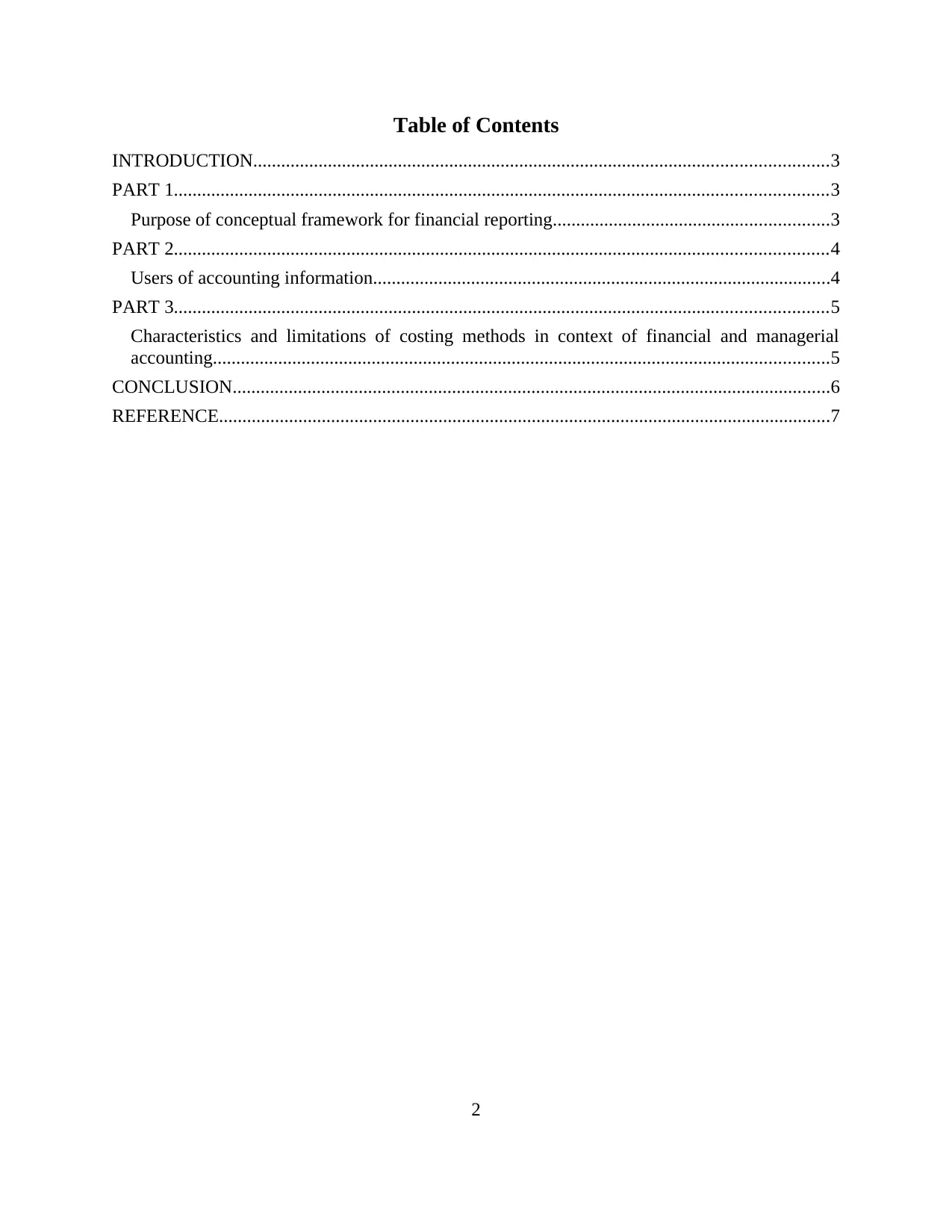
Table of Contents
INTRODUCTION...........................................................................................................................3
PART 1............................................................................................................................................3
Purpose of conceptual framework for financial reporting...........................................................3
PART 2............................................................................................................................................4
Users of accounting information..................................................................................................4
PART 3............................................................................................................................................5
Characteristics and limitations of costing methods in context of financial and managerial
accounting....................................................................................................................................5
CONCLUSION................................................................................................................................6
REFERENCE...................................................................................................................................7
2
INTRODUCTION...........................................................................................................................3
PART 1............................................................................................................................................3
Purpose of conceptual framework for financial reporting...........................................................3
PART 2............................................................................................................................................4
Users of accounting information..................................................................................................4
PART 3............................................................................................................................................5
Characteristics and limitations of costing methods in context of financial and managerial
accounting....................................................................................................................................5
CONCLUSION................................................................................................................................6
REFERENCE...................................................................................................................................7
2
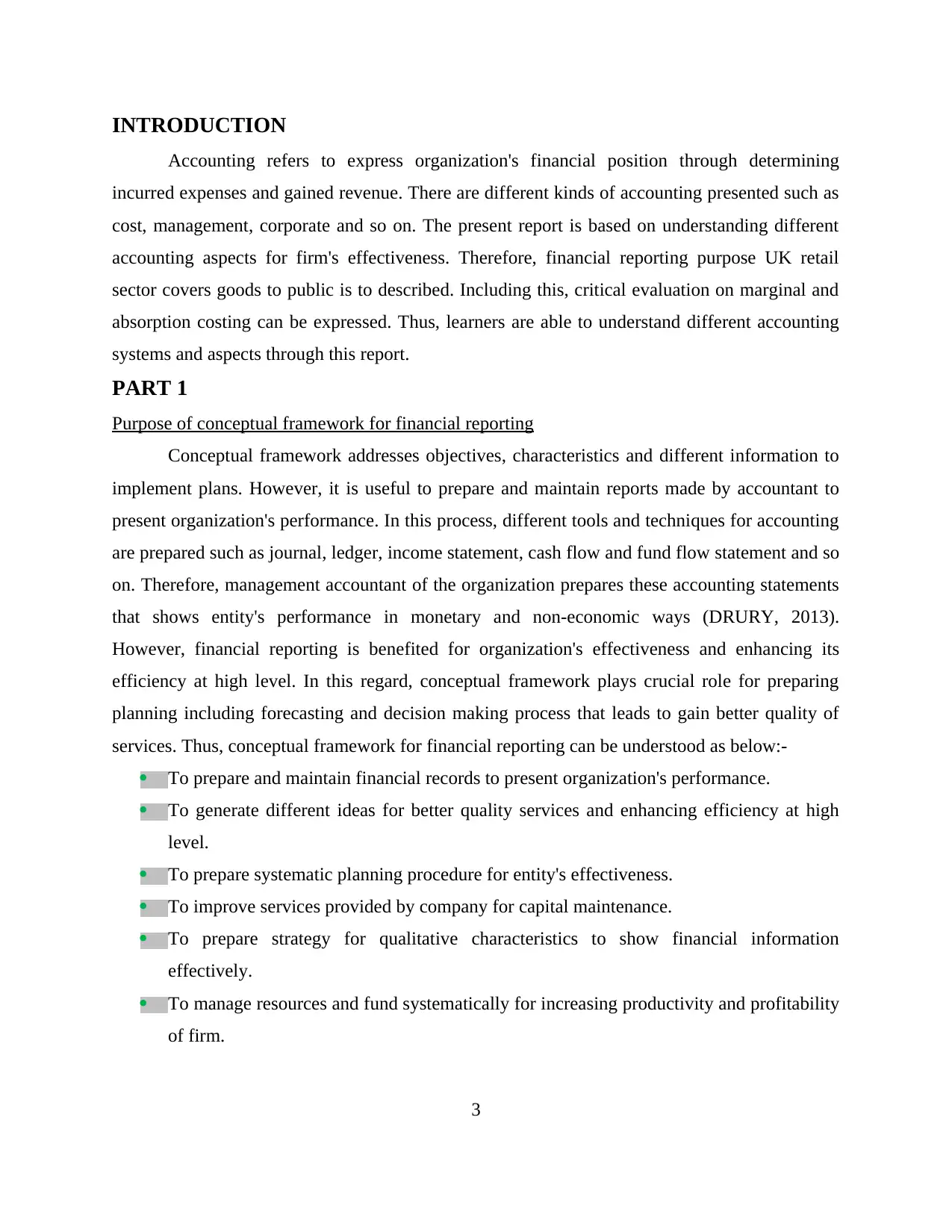
INTRODUCTION
Accounting refers to express organization's financial position through determining
incurred expenses and gained revenue. There are different kinds of accounting presented such as
cost, management, corporate and so on. The present report is based on understanding different
accounting aspects for firm's effectiveness. Therefore, financial reporting purpose UK retail
sector covers goods to public is to described. Including this, critical evaluation on marginal and
absorption costing can be expressed. Thus, learners are able to understand different accounting
systems and aspects through this report.
PART 1
Purpose of conceptual framework for financial reporting
Conceptual framework addresses objectives, characteristics and different information to
implement plans. However, it is useful to prepare and maintain reports made by accountant to
present organization's performance. In this process, different tools and techniques for accounting
are prepared such as journal, ledger, income statement, cash flow and fund flow statement and so
on. Therefore, management accountant of the organization prepares these accounting statements
that shows entity's performance in monetary and non-economic ways (DRURY, 2013).
However, financial reporting is benefited for organization's effectiveness and enhancing its
efficiency at high level. In this regard, conceptual framework plays crucial role for preparing
planning including forecasting and decision making process that leads to gain better quality of
services. Thus, conceptual framework for financial reporting can be understood as below:-
To prepare and maintain financial records to present organization's performance.
To generate different ideas for better quality services and enhancing efficiency at high
level.
To prepare systematic planning procedure for entity's effectiveness.
To improve services provided by company for capital maintenance.
To prepare strategy for qualitative characteristics to show financial information
effectively.
To manage resources and fund systematically for increasing productivity and profitability
of firm.
3
Accounting refers to express organization's financial position through determining
incurred expenses and gained revenue. There are different kinds of accounting presented such as
cost, management, corporate and so on. The present report is based on understanding different
accounting aspects for firm's effectiveness. Therefore, financial reporting purpose UK retail
sector covers goods to public is to described. Including this, critical evaluation on marginal and
absorption costing can be expressed. Thus, learners are able to understand different accounting
systems and aspects through this report.
PART 1
Purpose of conceptual framework for financial reporting
Conceptual framework addresses objectives, characteristics and different information to
implement plans. However, it is useful to prepare and maintain reports made by accountant to
present organization's performance. In this process, different tools and techniques for accounting
are prepared such as journal, ledger, income statement, cash flow and fund flow statement and so
on. Therefore, management accountant of the organization prepares these accounting statements
that shows entity's performance in monetary and non-economic ways (DRURY, 2013).
However, financial reporting is benefited for organization's effectiveness and enhancing its
efficiency at high level. In this regard, conceptual framework plays crucial role for preparing
planning including forecasting and decision making process that leads to gain better quality of
services. Thus, conceptual framework for financial reporting can be understood as below:-
To prepare and maintain financial records to present organization's performance.
To generate different ideas for better quality services and enhancing efficiency at high
level.
To prepare systematic planning procedure for entity's effectiveness.
To improve services provided by company for capital maintenance.
To prepare strategy for qualitative characteristics to show financial information
effectively.
To manage resources and fund systematically for increasing productivity and profitability
of firm.
3
⊘ This is a preview!⊘
Do you want full access?
Subscribe today to unlock all pages.

Trusted by 1+ million students worldwide
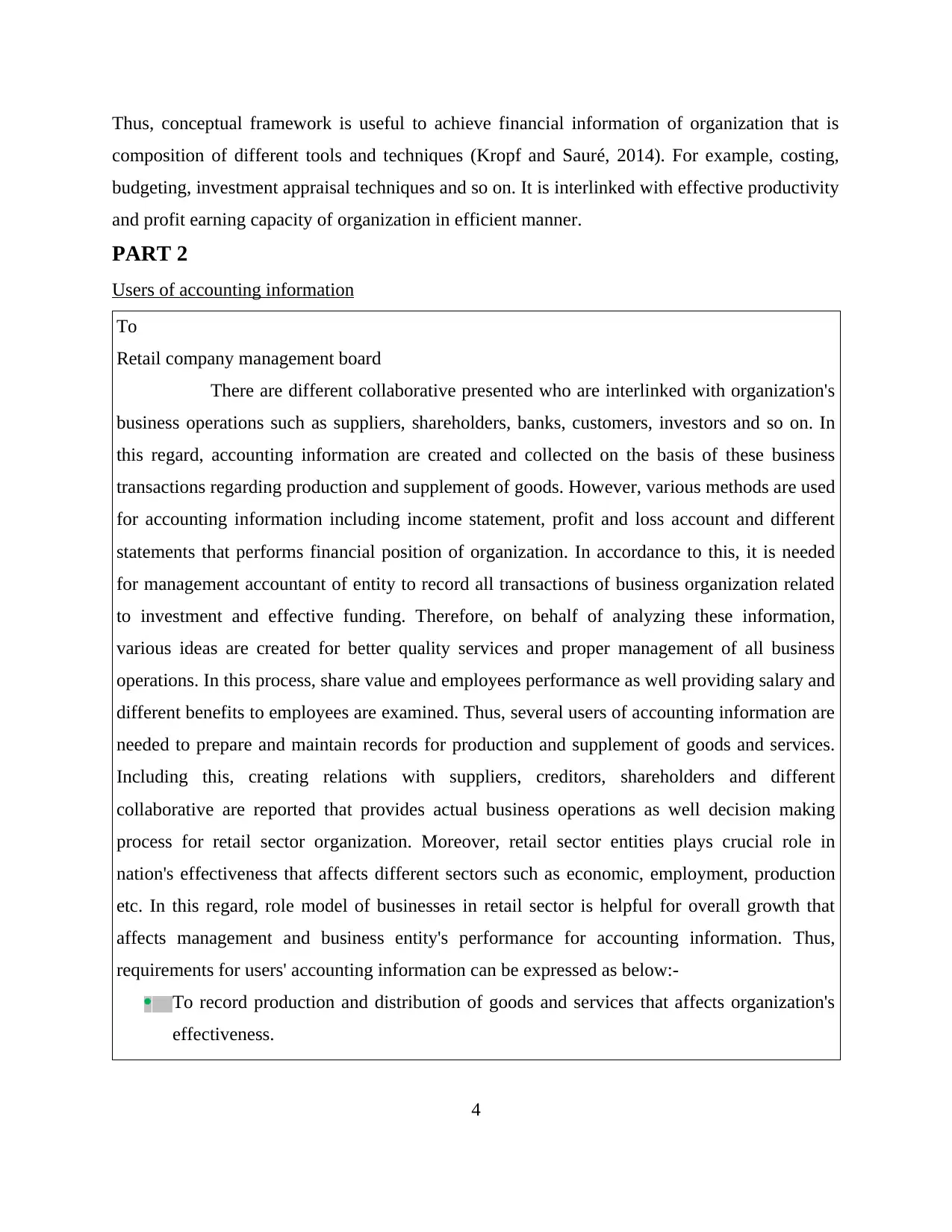
Thus, conceptual framework is useful to achieve financial information of organization that is
composition of different tools and techniques (Kropf and Sauré, 2014). For example, costing,
budgeting, investment appraisal techniques and so on. It is interlinked with effective productivity
and profit earning capacity of organization in efficient manner.
PART 2
Users of accounting information
To
Retail company management board
There are different collaborative presented who are interlinked with organization's
business operations such as suppliers, shareholders, banks, customers, investors and so on. In
this regard, accounting information are created and collected on the basis of these business
transactions regarding production and supplement of goods. However, various methods are used
for accounting information including income statement, profit and loss account and different
statements that performs financial position of organization. In accordance to this, it is needed
for management accountant of entity to record all transactions of business organization related
to investment and effective funding. Therefore, on behalf of analyzing these information,
various ideas are created for better quality services and proper management of all business
operations. In this process, share value and employees performance as well providing salary and
different benefits to employees are examined. Thus, several users of accounting information are
needed to prepare and maintain records for production and supplement of goods and services.
Including this, creating relations with suppliers, creditors, shareholders and different
collaborative are reported that provides actual business operations as well decision making
process for retail sector organization. Moreover, retail sector entities plays crucial role in
nation's effectiveness that affects different sectors such as economic, employment, production
etc. In this regard, role model of businesses in retail sector is helpful for overall growth that
affects management and business entity's performance for accounting information. Thus,
requirements for users' accounting information can be expressed as below:-
To record production and distribution of goods and services that affects organization's
effectiveness.
4
composition of different tools and techniques (Kropf and Sauré, 2014). For example, costing,
budgeting, investment appraisal techniques and so on. It is interlinked with effective productivity
and profit earning capacity of organization in efficient manner.
PART 2
Users of accounting information
To
Retail company management board
There are different collaborative presented who are interlinked with organization's
business operations such as suppliers, shareholders, banks, customers, investors and so on. In
this regard, accounting information are created and collected on the basis of these business
transactions regarding production and supplement of goods. However, various methods are used
for accounting information including income statement, profit and loss account and different
statements that performs financial position of organization. In accordance to this, it is needed
for management accountant of entity to record all transactions of business organization related
to investment and effective funding. Therefore, on behalf of analyzing these information,
various ideas are created for better quality services and proper management of all business
operations. In this process, share value and employees performance as well providing salary and
different benefits to employees are examined. Thus, several users of accounting information are
needed to prepare and maintain records for production and supplement of goods and services.
Including this, creating relations with suppliers, creditors, shareholders and different
collaborative are reported that provides actual business operations as well decision making
process for retail sector organization. Moreover, retail sector entities plays crucial role in
nation's effectiveness that affects different sectors such as economic, employment, production
etc. In this regard, role model of businesses in retail sector is helpful for overall growth that
affects management and business entity's performance for accounting information. Thus,
requirements for users' accounting information can be expressed as below:-
To record production and distribution of goods and services that affects organization's
effectiveness.
4
Paraphrase This Document
Need a fresh take? Get an instant paraphrase of this document with our AI Paraphraser
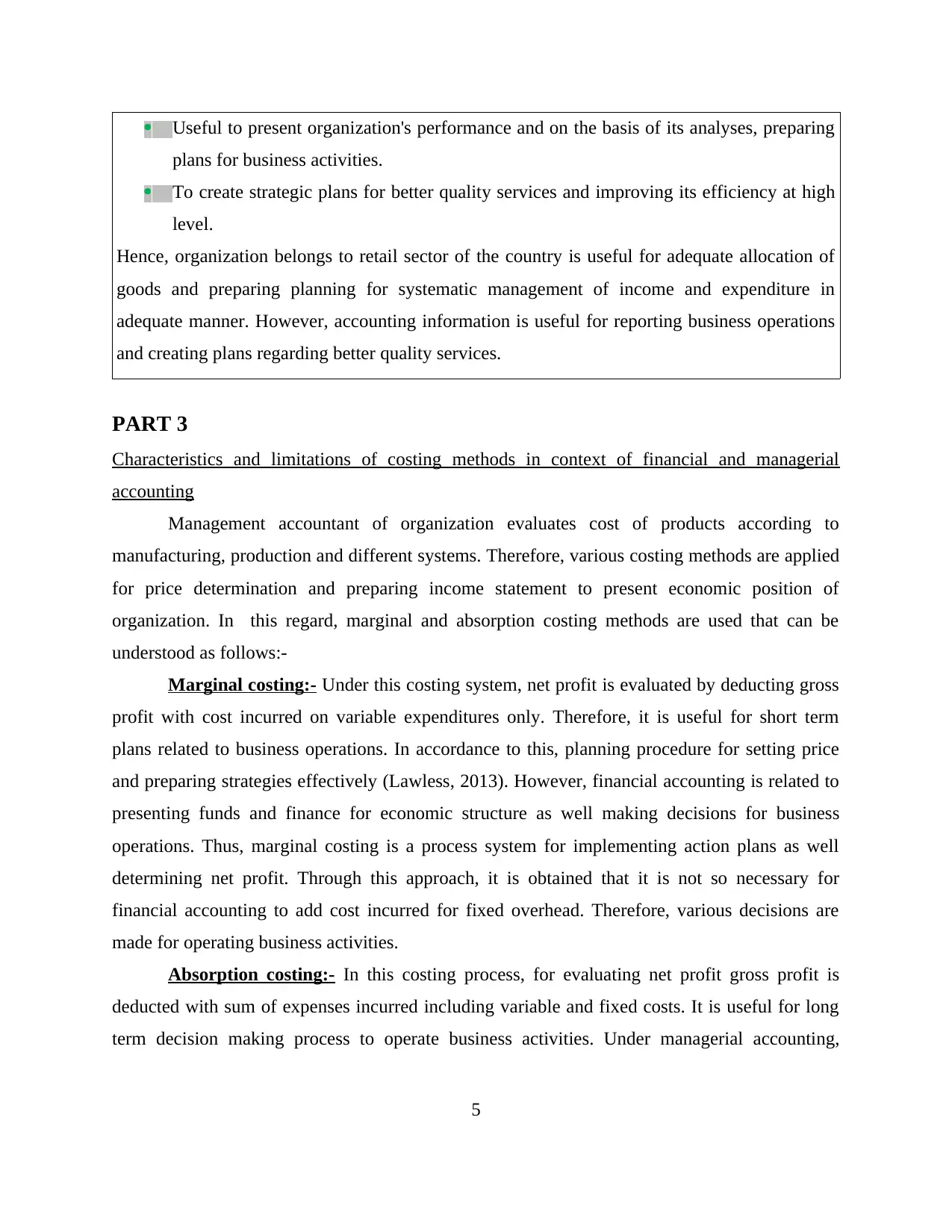
Useful to present organization's performance and on the basis of its analyses, preparing
plans for business activities.
To create strategic plans for better quality services and improving its efficiency at high
level.
Hence, organization belongs to retail sector of the country is useful for adequate allocation of
goods and preparing planning for systematic management of income and expenditure in
adequate manner. However, accounting information is useful for reporting business operations
and creating plans regarding better quality services.
PART 3
Characteristics and limitations of costing methods in context of financial and managerial
accounting
Management accountant of organization evaluates cost of products according to
manufacturing, production and different systems. Therefore, various costing methods are applied
for price determination and preparing income statement to present economic position of
organization. In this regard, marginal and absorption costing methods are used that can be
understood as follows:-
Marginal costing:- Under this costing system, net profit is evaluated by deducting gross
profit with cost incurred on variable expenditures only. Therefore, it is useful for short term
plans related to business operations. In accordance to this, planning procedure for setting price
and preparing strategies effectively (Lawless, 2013). However, financial accounting is related to
presenting funds and finance for economic structure as well making decisions for business
operations. Thus, marginal costing is a process system for implementing action plans as well
determining net profit. Through this approach, it is obtained that it is not so necessary for
financial accounting to add cost incurred for fixed overhead. Therefore, various decisions are
made for operating business activities.
Absorption costing:- In this costing process, for evaluating net profit gross profit is
deducted with sum of expenses incurred including variable and fixed costs. It is useful for long
term decision making process to operate business activities. Under managerial accounting,
5
plans for business activities.
To create strategic plans for better quality services and improving its efficiency at high
level.
Hence, organization belongs to retail sector of the country is useful for adequate allocation of
goods and preparing planning for systematic management of income and expenditure in
adequate manner. However, accounting information is useful for reporting business operations
and creating plans regarding better quality services.
PART 3
Characteristics and limitations of costing methods in context of financial and managerial
accounting
Management accountant of organization evaluates cost of products according to
manufacturing, production and different systems. Therefore, various costing methods are applied
for price determination and preparing income statement to present economic position of
organization. In this regard, marginal and absorption costing methods are used that can be
understood as follows:-
Marginal costing:- Under this costing system, net profit is evaluated by deducting gross
profit with cost incurred on variable expenditures only. Therefore, it is useful for short term
plans related to business operations. In accordance to this, planning procedure for setting price
and preparing strategies effectively (Lawless, 2013). However, financial accounting is related to
presenting funds and finance for economic structure as well making decisions for business
operations. Thus, marginal costing is a process system for implementing action plans as well
determining net profit. Through this approach, it is obtained that it is not so necessary for
financial accounting to add cost incurred for fixed overhead. Therefore, various decisions are
made for operating business activities.
Absorption costing:- In this costing process, for evaluating net profit gross profit is
deducted with sum of expenses incurred including variable and fixed costs. It is useful for long
term decision making process to operate business activities. Under managerial accounting,
5
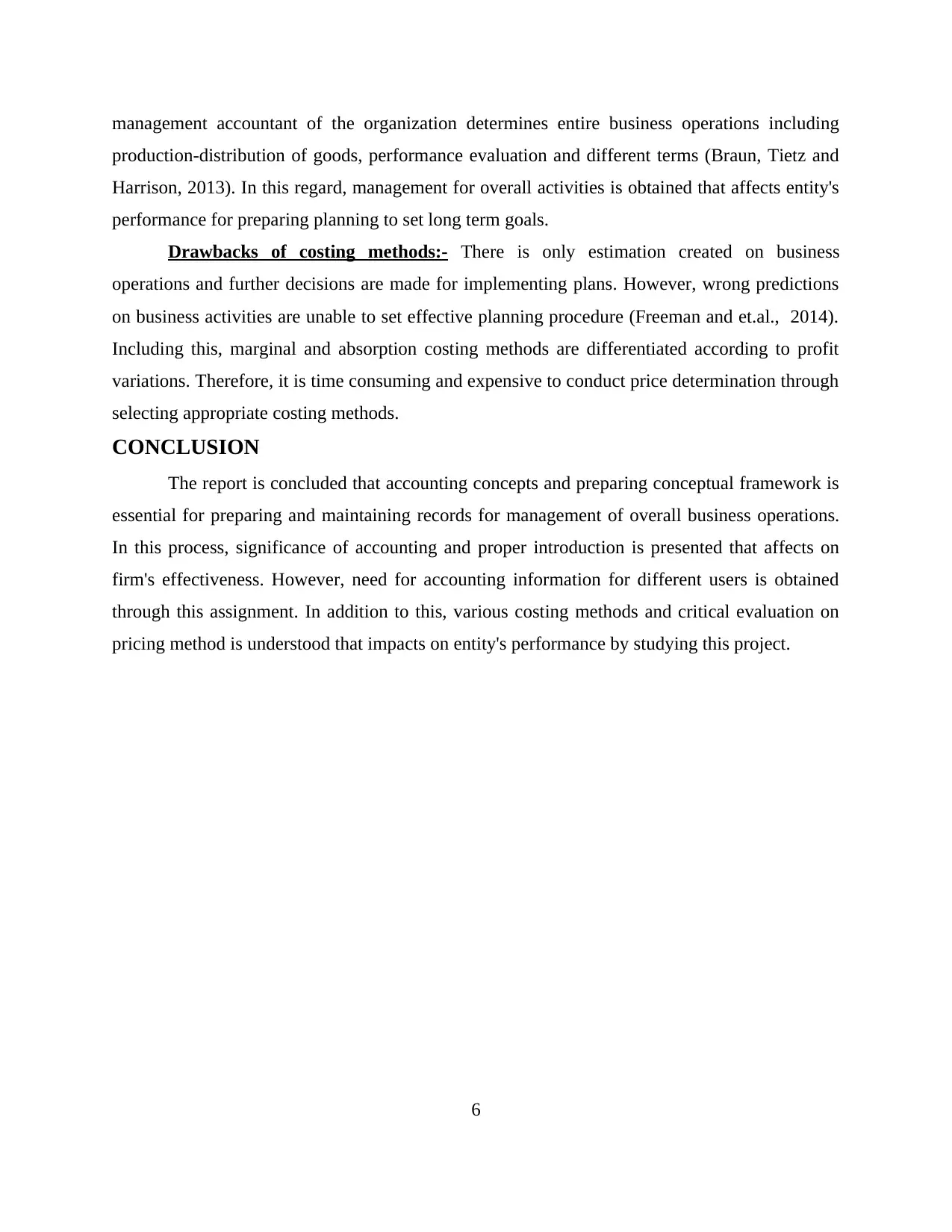
management accountant of the organization determines entire business operations including
production-distribution of goods, performance evaluation and different terms (Braun, Tietz and
Harrison, 2013). In this regard, management for overall activities is obtained that affects entity's
performance for preparing planning to set long term goals.
Drawbacks of costing methods:- There is only estimation created on business
operations and further decisions are made for implementing plans. However, wrong predictions
on business activities are unable to set effective planning procedure (Freeman and et.al., 2014).
Including this, marginal and absorption costing methods are differentiated according to profit
variations. Therefore, it is time consuming and expensive to conduct price determination through
selecting appropriate costing methods.
CONCLUSION
The report is concluded that accounting concepts and preparing conceptual framework is
essential for preparing and maintaining records for management of overall business operations.
In this process, significance of accounting and proper introduction is presented that affects on
firm's effectiveness. However, need for accounting information for different users is obtained
through this assignment. In addition to this, various costing methods and critical evaluation on
pricing method is understood that impacts on entity's performance by studying this project.
6
production-distribution of goods, performance evaluation and different terms (Braun, Tietz and
Harrison, 2013). In this regard, management for overall activities is obtained that affects entity's
performance for preparing planning to set long term goals.
Drawbacks of costing methods:- There is only estimation created on business
operations and further decisions are made for implementing plans. However, wrong predictions
on business activities are unable to set effective planning procedure (Freeman and et.al., 2014).
Including this, marginal and absorption costing methods are differentiated according to profit
variations. Therefore, it is time consuming and expensive to conduct price determination through
selecting appropriate costing methods.
CONCLUSION
The report is concluded that accounting concepts and preparing conceptual framework is
essential for preparing and maintaining records for management of overall business operations.
In this process, significance of accounting and proper introduction is presented that affects on
firm's effectiveness. However, need for accounting information for different users is obtained
through this assignment. In addition to this, various costing methods and critical evaluation on
pricing method is understood that impacts on entity's performance by studying this project.
6
⊘ This is a preview!⊘
Do you want full access?
Subscribe today to unlock all pages.

Trusted by 1+ million students worldwide
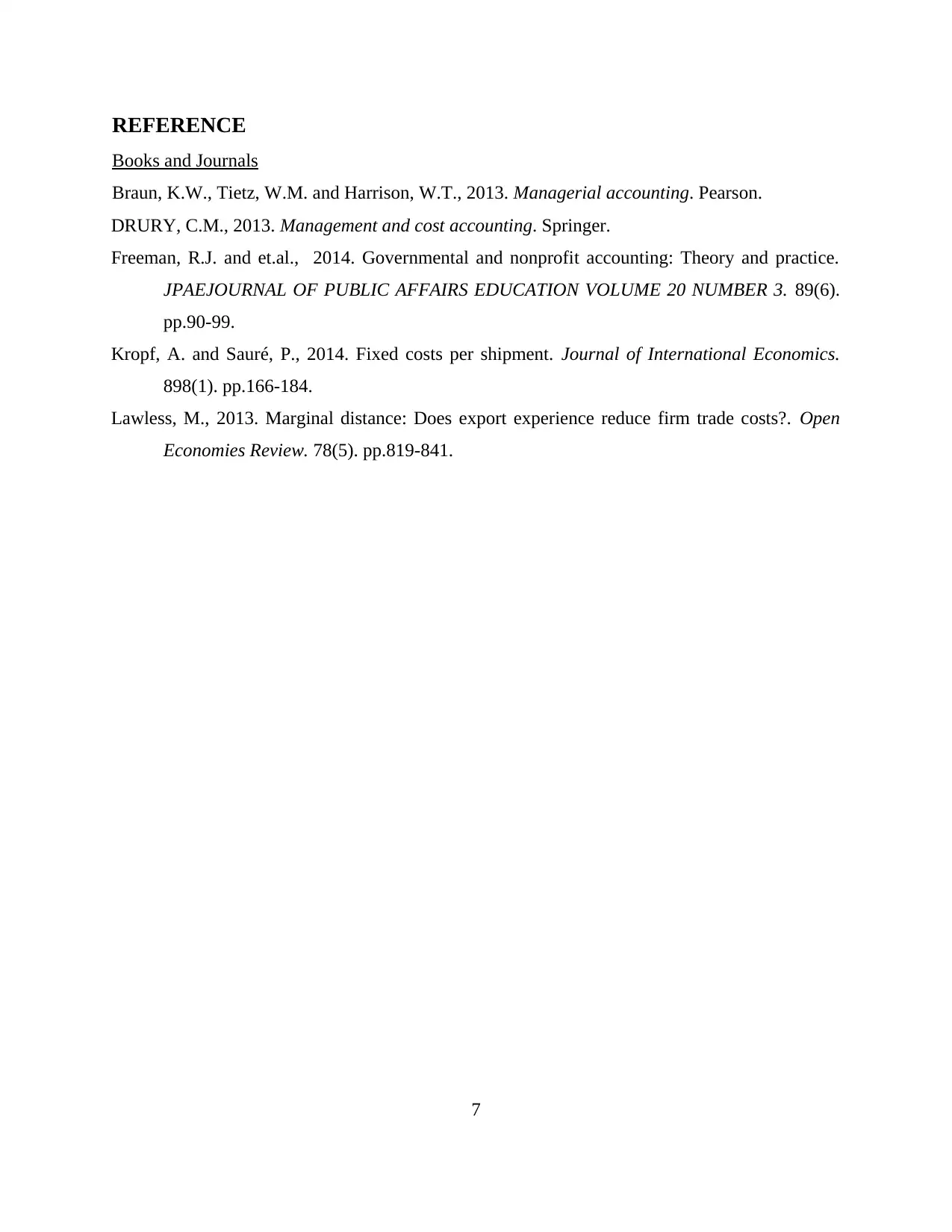
REFERENCE
Books and Journals
Braun, K.W., Tietz, W.M. and Harrison, W.T., 2013. Managerial accounting. Pearson.
DRURY, C.M., 2013. Management and cost accounting. Springer.
Freeman, R.J. and et.al., 2014. Governmental and nonprofit accounting: Theory and practice.
JPAEJOURNAL OF PUBLIC AFFAIRS EDUCATION VOLUME 20 NUMBER 3. 89(6).
pp.90-99.
Kropf, A. and Sauré, P., 2014. Fixed costs per shipment. Journal of International Economics.
898(1). pp.166-184.
Lawless, M., 2013. Marginal distance: Does export experience reduce firm trade costs?. Open
Economies Review. 78(5). pp.819-841.
7
Books and Journals
Braun, K.W., Tietz, W.M. and Harrison, W.T., 2013. Managerial accounting. Pearson.
DRURY, C.M., 2013. Management and cost accounting. Springer.
Freeman, R.J. and et.al., 2014. Governmental and nonprofit accounting: Theory and practice.
JPAEJOURNAL OF PUBLIC AFFAIRS EDUCATION VOLUME 20 NUMBER 3. 89(6).
pp.90-99.
Kropf, A. and Sauré, P., 2014. Fixed costs per shipment. Journal of International Economics.
898(1). pp.166-184.
Lawless, M., 2013. Marginal distance: Does export experience reduce firm trade costs?. Open
Economies Review. 78(5). pp.819-841.
7
1 out of 7
Related Documents
Your All-in-One AI-Powered Toolkit for Academic Success.
+13062052269
info@desklib.com
Available 24*7 on WhatsApp / Email
![[object Object]](/_next/static/media/star-bottom.7253800d.svg)
Unlock your academic potential
Copyright © 2020–2025 A2Z Services. All Rights Reserved. Developed and managed by ZUCOL.





